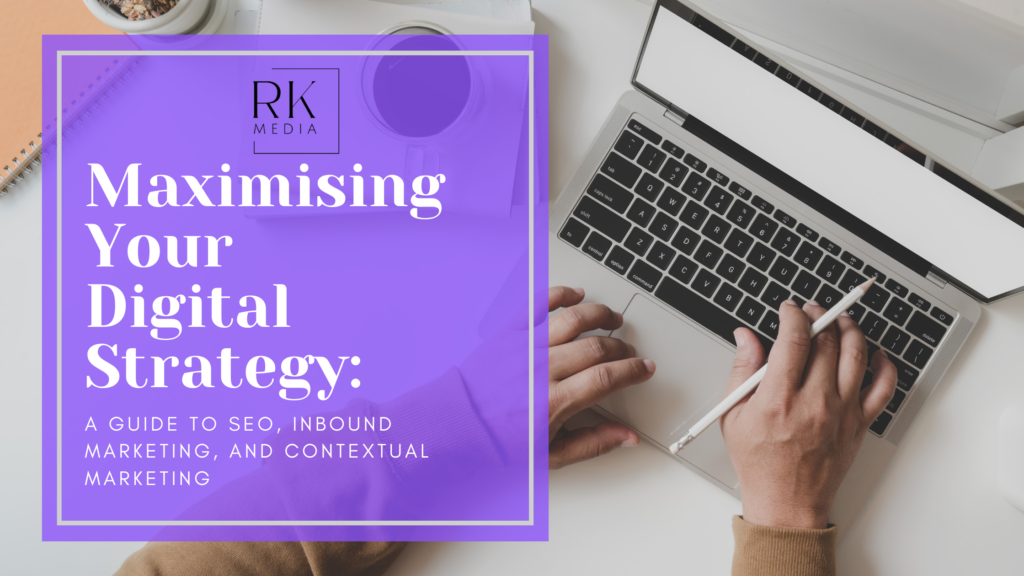Maximising Your Digital Strategy:
A Guide to SEO, Inbound Marketing, and Contextual Marketing

1. What is Search Engine Optimisation (SEO)?
Search Engine Optimisation (SEO) refers to the process of optimising your website and its content to increase visibility in search engine results pages (SERPs). The aim is to improve the ranking of your website so that it appears higher when users search for relevant keywords or phrases. SEO is a crucial element of any digital marketing strategy because most online experiences start with a search engine, and ranking higher in search results can significantly increase organic traffic to your website.
There are several key components of SEO, including:
- Keyword Research: Identifying relevant keywords that your target audience uses when searching for your products or services. Integrating these keywords strategically in your website content can boost your ranking.
- On-Page SEO: Optimising individual web pages by improving title tags, meta descriptions, and other on-page elements. This ensures that search engines understand the content and relevance of your pages.
- Technical SEO: Ensuring your website’s technical aspects, such as site speed, mobile responsiveness, and security, meet search engine standards.
- Content Creation: Producing high-quality, informative, and engaging content that addresses your audience’s needs and questions. This helps build authority and encourages other websites to link back to your content (backlinks), further improving your SEO.
SEO is a long-term strategy that requires consistent effort but yields sustainable results by driving organic traffic to your site and building credibility over time.
2. What is Inbound Marketing?
Inbound Marketing is a marketing approach focused on attracting customers through valuable content and experiences tailored to their interests and needs. Unlike traditional marketing methods, which often involve interruptive advertising (such as TV adverts or cold calls), inbound marketing aims to pull customers towards a business naturally.
The key stages of inbound marketing include:
- Attract: The goal is to attract the right people to your website by providing relevant and helpful content, such as blog posts, videos, or social media updates. SEO plays a crucial role here, as it helps make your content discoverable through search engines.
- Engage: Once you have attracted visitors, the next step is to engage them through meaningful interactions. This could include using email marketing, offering free resources like e-books or webinars, or providing live chat support. The aim is to build trust and establish a relationship with your audience.
- Delight: The final stage is about delighting your audience and turning them into promoters of your brand. This can be achieved through exceptional customer service, personalised follow-ups, and by consistently providing value even after a purchase.
Inbound marketing is highly effective because it aligns with the way modern consumers interact with brands. It focuses on delivering value and solving customer problems, leading to higher engagement and more conversions.
3. What is Contextual Marketing?
Contextual Marketing is the practice of delivering targeted advertising and content based on the user’s context, such as their location, behaviour, or recent online activities. This strategy allows businesses to create highly relevant and personalised marketing messages that resonate with their audience at the right time.
Contextual marketing often uses tools like:
- Behavioural Data: Analysing user behaviour, such as the pages they visit, the products they view, and their previous interactions with your brand, to provide personalised recommendations and adverts.
- Geotargeting: Using location data to offer users relevant information or promotions based on where they are. For instance, a restaurant might send a discount offer to users within a specific radius.
- Dynamic Content: Adjusting website or email content in real-time based on user behaviour or preferences. This could involve displaying products that match a user’s past searches or showing region-specific offers.
By leveraging data and insights, contextual marketing ensures that customers receive relevant and timely information, enhancing their overall experience with your brand. It also increases the likelihood of conversions since the content is aligned with the user’s current needs and interests.
How These Strategies Work Together
Each of these marketing strategies—SEO, inbound marketing, and contextual marketing—plays a unique role in an effective digital marketing plan. When combined, they can create a comprehensive approach that attracts, engages, and converts customers:
- SEO ensures that your content is visible and discoverable, driving traffic to your site and laying the foundation for other strategies to work.
- Inbound Marketing captures and nurtures this audience by offering valuable content and building lasting relationships.
- Contextual Marketing then delivers personalised experiences that align with the user’s behaviour and preferences, increasing engagement and conversion rates.
By understanding and integrating these methods, small businesses can create a powerful marketing strategy that not only attracts potential customers but also builds trust and loyalty over time.
Conclusion
SEO, inbound marketing, and contextual marketing are essential tools in today’s digital landscape. By optimising your website, providing valuable content, and delivering personalised experiences, you can grow your business and connect with your audience in meaningful ways. Whether you’re just starting out or looking to refine your strategy, incorporating these approaches can set your brand up for long-term success.
